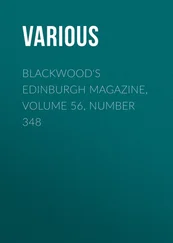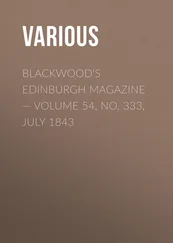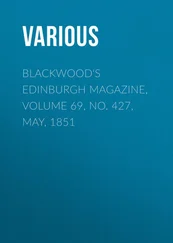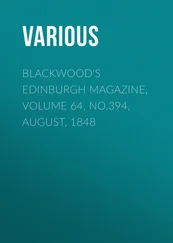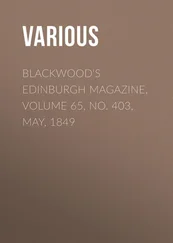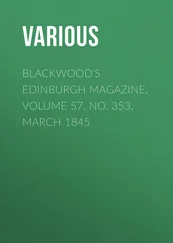Various - Blackwood's Edinburgh Magazine, Volume 66, No. 408, January 1849
Здесь есть возможность читать онлайн «Various - Blackwood's Edinburgh Magazine, Volume 66, No. 408, January 1849» — ознакомительный отрывок электронной книги совершенно бесплатно, а после прочтения отрывка купить полную версию. В некоторых случаях можно слушать аудио, скачать через торрент в формате fb2 и присутствует краткое содержание. Издательство: Иностранный паблик, Жанр: periodic, foreign_edu, Путешествия и география, на английском языке. Описание произведения, (предисловие) а так же отзывы посетителей доступны на портале библиотеки ЛибКат.
- Название:Blackwood's Edinburgh Magazine, Volume 66, No. 408, January 1849
- Автор:
- Издательство:Иностранный паблик
- Жанр:
- Год:неизвестен
- ISBN:нет данных
- Рейтинг книги:4 / 5. Голосов: 1
-
Избранное:Добавить в избранное
- Отзывы:
-
Ваша оценка:
- 80
- 1
- 2
- 3
- 4
- 5
Blackwood's Edinburgh Magazine, Volume 66, No. 408, January 1849: краткое содержание, описание и аннотация
Предлагаем к чтению аннотацию, описание, краткое содержание или предисловие (зависит от того, что написал сам автор книги «Blackwood's Edinburgh Magazine, Volume 66, No. 408, January 1849»). Если вы не нашли необходимую информацию о книге — напишите в комментариях, мы постараемся отыскать её.
Blackwood's Edinburgh Magazine, Volume 66, No. 408, January 1849 — читать онлайн ознакомительный отрывок
Ниже представлен текст книги, разбитый по страницам. Система сохранения места последней прочитанной страницы, позволяет с удобством читать онлайн бесплатно книгу «Blackwood's Edinburgh Magazine, Volume 66, No. 408, January 1849», без необходимости каждый раз заново искать на чём Вы остановились. Поставьте закладку, и сможете в любой момент перейти на страницу, на которой закончили чтение.
Интервал:
Закладка:
I believe they studied nature through coloured glasses; and we learn from Mrs Merrifield that Gaspar Poussin used a black mirror, which had been bequeathed to him by Bamboccio. The works of some of the Flemish painters evidently show that they used such a mirror.
Have I not, then, reached Lynmouth yet? I found it in full leafage, and the little river as clear as amber, and like it in colour. It is always beautiful, and variable too – after rain it assumes more variety of colour, and of great richness. For most part of the time of my visit, it was more shallow than I had ever seen it. I was pleased that it was so, though I heard many complaints on that score. To those who sketch close to the water, it is, in fact, an advantage; for where the scenery is so confined, it is a great thing to be able to reach the large stones in mid-stream, and thus many new views are obtained; and when you are pretty close to water, whether it be a fall, or still, there is really but very little difference whether the river be full or not – the falls still retain sufficient body, and the still pools are sufficiently wide.
There are but two parties who know anything of the painter-scenery of Lynmouth – the sketchers and the anglers. The common road generally taken by tourists shows not half the beauty of the place. Did Lynmouth appear less beautiful? – certainly not. I easily recognised the chosen spots, and was surprised to find what little change had taken place. I knew individual trees perfectly, and, strange to say, they did not seem to have acquired growth. There were apparently the same branches stretching over the stream.
In one spot where large ledges of rock shoot out in mid-stream, down whose grooves the river rushes precipitously, (I had, sixteen years ago, sketched the scene,) there was growing out of the edge of the rock a young ash-tree shoot – to my surprise, there it was still, or the old had decayed, and a similar had sprang up. There is something remarkable in this continued identity, year after year, as if the law of mutability had been suspended. Yet there were changes. I remember sketching by a little fall of the river, where further progress was staid by a large mass of projecting rock. I felt sure there must be fine subjects beyond, and in my attempt to reach it from the opposite side by climbing, and holding by the boughs of a tree, one broke off, and I fell into the cauldron. I found now that the whole mass of this ledge of rock had given way, and opened a passage, and one of no great difficulty. Here, as I suspected, were some very fine studies. The place where I descended is about half a mile, or less, from Lynmouth, where the road turns, near to a little bridge across a watercourse intercepting the road. The view of this little fall from above is singularly beautiful; and, being so much elevated, you see the bed of the river continuous for a long distance, greatly varied. I know no place where there are such fine studies of this kind, though they are rarely taken, being only parts for composition – the whole not making a view.
Was Lynmouth, then, to me as it was? – not quite. The interval of years had not, I trust, been lost. If there was little change in the place, there was a change in the mind's eye and head of the sketcher. Though I recognised nearly all the spots where I had sketched, I found many new – some that might have escaped me, because I had not taken the feeling with me, at least not in the degree, in which I now possessed it. During all the years that had intervened, I had scarcely painted a single view. I could not but observe that the new scenes were those more especially suggestive, leading to the ideal.
A friend who was part of the time with me observed that he had thought some of my pictures, which he had seen, compositions without the warranty of nature; but he now saw that nature supplied me with what I wanted, and acknowledged that the sketches were correct. It was then I observed that the sketcher may find almost everywhere what he has learnt to look for. The fact is, that it is not whole and large scenery, nor the most beautiful, that best suits the painter, but those parts which he can combine. The real painter looks to nature for form and colour, the elements of his art: upon these he must work; and they seldom reach any great magnitude, or are diffused over large space.
Why is it, that generally what we term beautiful scenery was seldom the ground of the old painters? They were not, generally speaking, painters of views; and why not? There the pictures were made for them. They, and all the world had the thing before them to love and to admire – it was already done; there was no room for their genius, which is a creative, not an imitative faculty. The scene for every eye was not theirs. They found that, by their art, they could take nature's best feeling, even from her fragments. It requires not an Alp to portray grandeur. Fifty feet of rock, precipitous or superimpending, will better represent the greatness of danger; for it is a more immediate and solid mass to crush the intruder, and the form may frown with a demon malice. The whole awe of darkness may be felt in a cavern of a few feet space. Indeed, it may be almost said that largeness is not to be obtained on the canvass, by the largeness of whole extensive scenes in nature, but by the continuous lines of near masses: whatever is actually largest in nature – the forest and the mountain – in art may with advantage occupy the smallest space. For the best magnitude here is in perspective, and in that aerial tone which, as a veil, half conceals, and thereby makes mysterious, and converts into one azure whole the parts which would, otherwise seen, but break up the great character. The Arabian genii were greatest when dimly seen through smoke and vapour.
Art, indeed, differs from nature in this, as regards the pleasure derived through the eye, that nature allows you many unperspective views at many instant glances, and therefore surprises you, if I may so express it, with a perspective impossibility, of which the judgment at the time is not cognisant; whereas art is bounded by a rule, looks not all around, and comprehends by mind beyond the eye, but is constrained to frame in the conception. It must, therefore, make to itself another power – and this power it finds in form, in light and shade, and colour, all which are in greater intensity and force in the fragmentary parts than in the whole and large scenes. It is a step for the young artist to believe that art and nature are not and should not be the same – that they are essentially different, and use their materials differently, have other rules of space and largeness. If art be more limited, its power is greater by being more condensed, – and its impressions more certain, because more direct, and not under the vague and changeable process of making an idea from many perspectives.
If there be truth in these remarks, we may see why the old masters left untouched those scenes which are the delight of tourists. To copy the scene before them was to put their creative faculty in abeyance. It was only to work after a given pattern – and that pattern imperfect – of a whole which defied the laws of optics. I here speak almost entirely of the Italian masters, both the historical, and more strictly the landscape painters. The Flemish and Dutch schools had mostly another aim, and were more imitative; hence they are more easily understood, but felt with a far less passion. But even these, far from undervaluing the conventional aids of art, applied as much of them as the nature of their subjects would admit.
But the sketcher must not consider himself in his studies when he is out with his portfolio. However he may select, he must be faithful. And this fidelity I have seen painters of great skill often unwisely contemn, become too conventional, both in their drawing and colouring. It requires much practice of the eye, as well as that knowledge which constitutes taste, to frame in as it were pictures, from the large space that fills the eye. Nothing is more useful than to carry in the portfolio a light frame of stiff paper or wood, and to hold it up, so as actually to frame in pictures, and thus to experimentalise upon the design, and see what shiftings of the frame make the best choice. It is an assistance even to the most practised in composition.
Читать дальшеИнтервал:
Закладка:
Похожие книги на «Blackwood's Edinburgh Magazine, Volume 66, No. 408, January 1849»
Представляем Вашему вниманию похожие книги на «Blackwood's Edinburgh Magazine, Volume 66, No. 408, January 1849» списком для выбора. Мы отобрали схожую по названию и смыслу литературу в надежде предоставить читателям больше вариантов отыскать новые, интересные, ещё непрочитанные произведения.
Обсуждение, отзывы о книге «Blackwood's Edinburgh Magazine, Volume 66, No. 408, January 1849» и просто собственные мнения читателей. Оставьте ваши комментарии, напишите, что Вы думаете о произведении, его смысле или главных героях. Укажите что конкретно понравилось, а что нет, и почему Вы так считаете.

